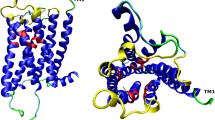Summary
Kinetic, saturation and competition binding studies were conducted on the muscarinic receptor binding sites labeled by [3H]N-methylscopolamine ([3H]NMS) in membranes prepared from NG108-15 cells. The pharmacology of the NG108-15 cell muscarinic receptors was compared to that of the M1 receptors of rat cortex labeled using [3H]pirenzepine, the M2 and M3 receptors of rat heart and submaxillary gland, respectively, labeled using [3H]NMS and the muscarinic receptors of the PC12 cell line also labeled using [3H]NMS.
The rate of dissociation of [3H]NMS from the NG10815 cell muscarinic receptor was similar to that obtained at the M3 receptor and at the muscarinic receptor of the P12 cells but was slower that the dissociation rate obtained at the M2 cardiac muscarinic receptor. The Kd of [3H]NMS in the NG108-15 cells was significantly lower than that obtained at the M2 and M3 receptor but was similar to the Kd obtained in PC12 cells. In competition studies the affinity estimates for AF-DX 116, 4-DAMP, methoctramine and pirenzepine were not consistent with the presence of either an M1, M2 Or M3 receptor but were identical to the affinity estimates obtained at the muscarinic receptor of the PC12 cell line.
On the basis of these data we conclude that the muscarinic receptor present in the NG108-15 cells is different to the M1, M2 or M3 subtypes already described but is similar to the muscarinic receptor present in the PC12 cell line. Since NG108-15 cells expresses mRNA for the m4 muscarinic receptor gene described by Bonner et al. (1987) we propose that the muscarinic receptors present in this cell line be denoted as M4 receptors.
Similar content being viewed by others
References
Akiyama K, Watson M, Roeske WR, Yamamura HI (1984) Highaffinity [3H]pirenzepine binding to putative M1 muscarinic sites in the neuroblastoma x glioma cell line (NG 108–15). Biochem Biophys Res Commun 119:289–297
Bonner TI, Buckley NJ, Young AC, Bran MR (1987) identificatin of a family of muscarinic acetylcholine receptor genes. Science 237:527–532
Cheng Y-C, Prusoff WH (1973) Relationship between the inhibition constant (K1) and the concentration of inhibitor which causes 50% inhibition (IC50) of an enzymatic reaction. Biochem Pharmacol 22:3099–3108
De Jonge A, Doods HN, Riesbos J, Van Zweiten PMBW (1986) Heterogeneity of muscarinic receptor binding sites in rat brain, submandibular gland and atrium. Br J Pharmacol 89 (Suppl):551 P
Doods HN, Mathy M-J, Davidesko D, van Charldrorp KJ, de Jonge A, van Zweiten PA (1987) Selectivity of muscarinic antagonists in radioligand and in vivo experiments for the putative M1, M2 and M3 receptors. J Pharmacol Exp Ther 242:257–262
Evans T, Mchardy MS, Tanner LL Harden TK (1984) Muscarinic cholinergic receptors of two cell lines that regulate cyclic AMP metabolism by different molecular mechanisms. Mol Pharmacol 26:395–404
Evans T, Martin MW, Hughes AR, Harden TK (1985) Guanine nucleotide-sensitive, high affinity binding of carbachol to muscarinic cholinergic receptors of 1321 N1 astrocytoma cells is insensitive to pertussis toxin. Mol Pharmacol 27:32–37
Fisher SK, Heacock AM (1988) A putative M3 muscarinic cholinergic receptor of high molecular weight couples to phosphoinositide hydrolysis in human SK-N-SH neuroblastoma cells. J Neurochem 50:984–987
Hammer R, Giachetti A (1982) Muscarinic receptor subtypes: M1 and M2. Biochemical and functional characterization. Life Sci 31:2991–2994
Kerlavage AR, Fraser CM, Venter JC (1987) Muscarinic cholinergic receptor structure: molecular biological support for subtypes. Trends Pharmacol Sci 8:12–16
Kunysz EA, Michel AD, Whiting RL, Wood K (1989) The human astrocytoma cell line 1321 N1 contains M2-glandular type muscarinic receptors linked to phosphoinositide turnover. Br J Pharmacol 96:271–278
Kurose H, Katada T, Amano T, Ui M (1983) Specific uncoupling by islet-activating protein, pertussis toxin, of negative signal transduction via alpha-adrenergic, cholinergic and opiate receptors in neuroblastoma x glioma hybrid cells. J Biol Chem 258:4870–4875
Liang M, Martin MW, Harden TK (1987) [3H]propylbenzylcholine mustard-labeling of muscarinic cholinergic receptors that selectively couple to phospholipase C or adenylate cyclase in two cultured cell lines. Mol Pharmacol 32:443–449
Michel AD, Whiting RL (1988) Methoctramine, a polymethylene tetraamine, differentiates three subtypes of muscarinic receptor in direct binding studies. Eur J Pharmacol 145:61–66
Michel AD, Stefanich E, Whiting RL (1988) PC12 cells contain an atypical muscarinic receptor. Br J Pharmacol, Proceedings of the Dublin meeting
Peralta EG, Ashkenazi A, Winslow JW, Smith DH, Ramachandran J, Capon DJ (1987) Distinct primary structures, ligand binding properties and tissue specific expression of four human muscarinic acetylcholine receptors. EMBO J 6:3923–3929
Peralta EG, Winslow JG, Ashkenazi A, Smith DH, Ramachandran J, Capon DJ (1988) Molecular properties of muscarinic receptors. Trends Pharmacol Sci 9 (Suppl):6–11
Author information
Authors and Affiliations
Additional information
Send offprint requests to A. Michel at the above address
Rights and permissions
About this article
Cite this article
Michel, A.D., Delmendo, R., Stefanich, E. et al. Binding characteristics of the muscarinic receptor subtype of the NG108-15 cell line. Naunyn-Schmiedeberg's Arch Pharmacol 340, 62–67 (1989). https://doi.org/10.1007/BF00169208
Received:
Accepted:
Issue Date:
DOI: https://doi.org/10.1007/BF00169208



